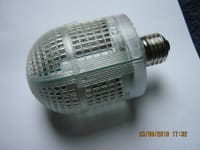
Ultra high efficiency LED light bubs and luminaires using a radically different patented method whereby a controlled constant current is generated from a zero voltage switched semi-resonant boost converter supplying a longer chain of small LED’s at very high power factor and virtually no EMI. The low current provides low losses.
This provides driver efficiencies to 98% on 240V supply with power factor of 0.993, very low harmonics and luminous efficacy of 90-110 lumens/watt, and where colour rendering can arranged to be >90 by additive colour mixing. Although the small LED quantities are higher than using the much more expensive ‘High Brightness’ LED’s, these small LED’s are becoming very low cost as they are fully machine assembled and virtually all parts can be fitted as SMT, resulting in much lower assembly and overall costs. This makes 100W ‘incandescent equivalents’ in a conventional bulb size possible, as well as PAR bulbs, tube lights and panels.
Each of the individual LED’s produces little local heat and is individually cooled by PCB track and/or small SMT tinned copper fins, which, with airflow through the bulb provides exceptional cooling without large finned heatsinks or the need for isolation. Not only does this result in a very light (and almost unbreakable when dropped) bulb or fitment, it also enables an LED temperature rise of the order of only 30DegreesC which depending on the choice of LED in turn provides a projected lifetime of 100K hours at 45C (or 400K hours at 25C), (including the extra long life electrolytic capacitors), with extremely low thermal cycling of soldered joints and other parts. This leads to the option of permanent luminaires in place of removable bulbs. A high tech fluopolymer dip coating allows the bulb to be washed and dried should it get dirty with such extended life.
The LED’s can be directed to give light in near spherical distribution or made directional as desired. The light ripple (or flicker) is an imperceptible 3% peak to peak and the circuit is forward and reverse phase dimmable with high efficiency, a logarithmic dimming curve to match incandescent dimming, and unlike most designs continues to have low light ripple even when dimmed.
A user adjustable sensor mounted in each bulb allows automatic dimming to be selected thus saving even more energy on days when the sun shines but no-one switches off the lights. An option is remote controlled dimming from a tiny remote which has both a flashing LED so it can be located in the dark, and is self charging from a photocell so that batteries never need to be replaced. Another option is inbuilt occupancy detection (not using a PIR).
-
Awards
-
 2012 Top 100 Entries
2012 Top 100 Entries
Like this entry?
-
About the Entrant
- Name:Alistair Macfarlane
- Type of entry:individual
- Software used for this entry:Spectrum Microcap V10
- Patent status:pending













